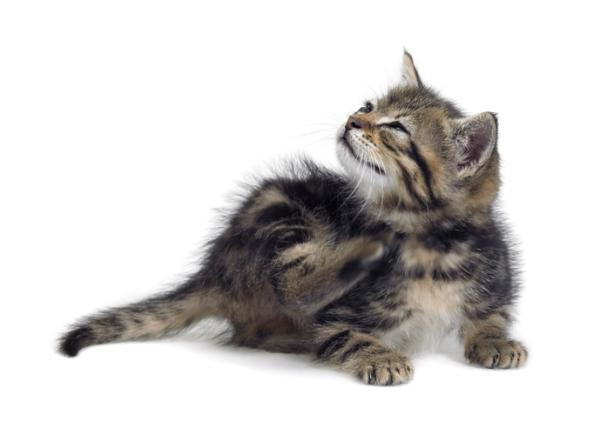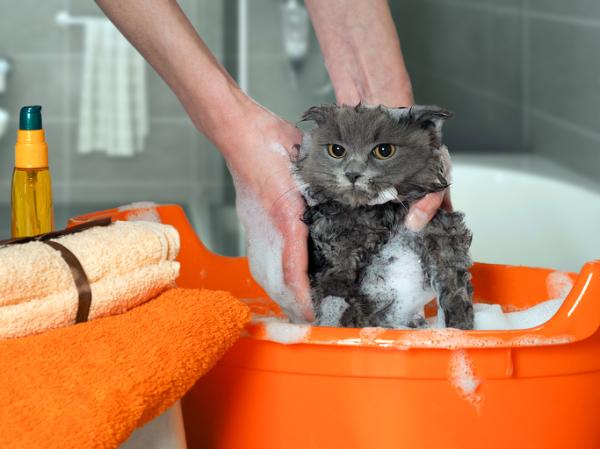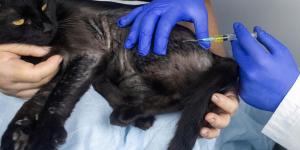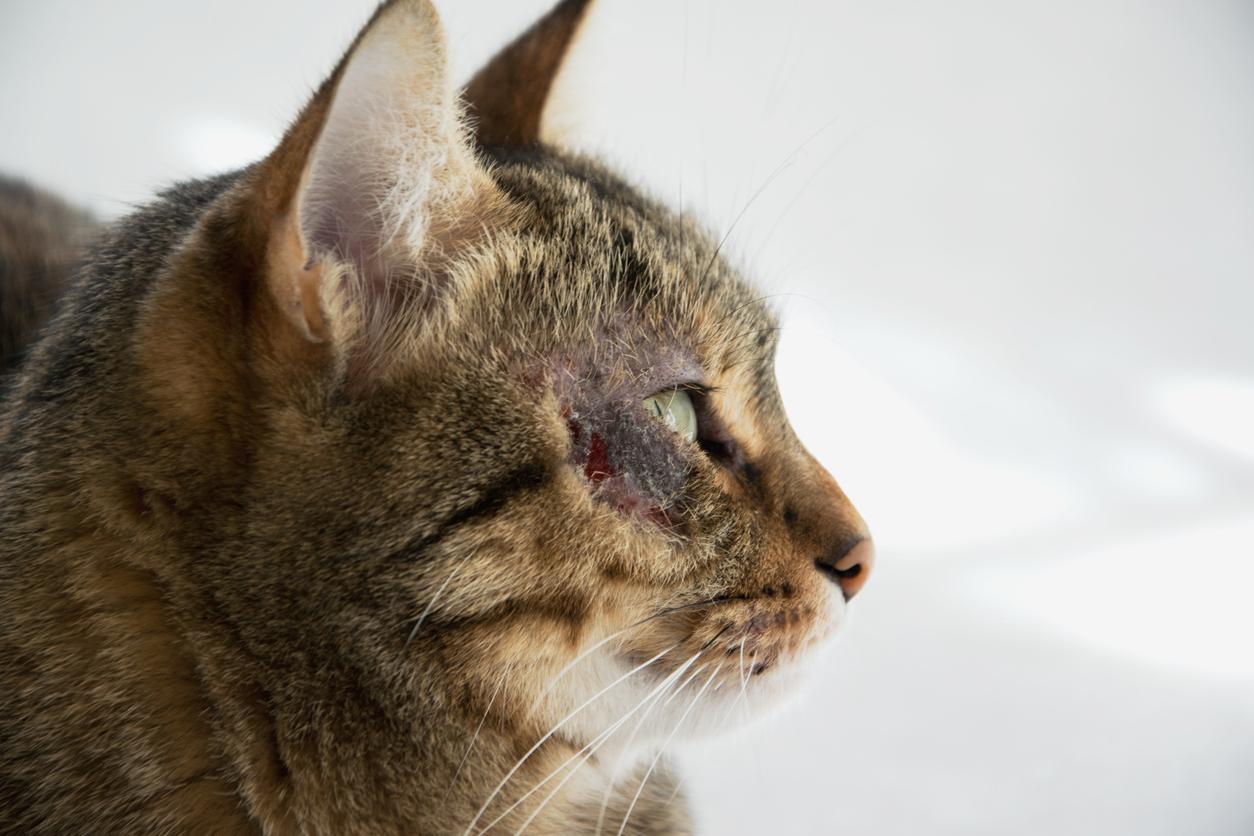Miliary Dermatitis in Cats - Causes, Symptoms and Care



See files for Cats
Feline miliary dermatitis is a disease complex that manifests itself in cats through the appearance of inflammation and rashes with crust around different areas of the cat's body such as the neck, head, back and other places. If you notice that your cat has recently been scratching and has several patches that appear red, then they may be suffering from this disease. At AnimalWised, we'd like to give you a complete guide so that you can detect and treat this disease in your feline friend. Keep on reading to know everything about miliary dermatitis in cats to know how to act if this is your cat's problem.
What is miliary dermatitis?
Known as scabby cat disease or feline eczema too, miliary dermatitis in cats is a skin inflammation that owes its name to the lesions, or papules, that appear on the cat's skin, which resemble millet seeds, thus 'miliary'. Dermatitis is usually the result of an allergic reaction, the most common being flea bite allergy, which is why it is commonly associated with this condition. However, as we'll see below, there are also other causes that can cause feline miliary dermatitis. According to the Animal Heath Trust[1], the resulting pruitus can vary depending on the severeness of each case and can affect cats of any age, breed and sex indistinctly.
Causes of miliary dermatitis in cats
As mentioned above, the most common cause of feline miliary dermatitis is flea bite allergy. However, at AnimalWised we'd like to share a complete list of the reasons why miliary dermatitis in cats may appear:
Allergy related conditions
- Hypersensitivity to flea bites
- Ectoparasites such as Trombicula, Felicola, Otodectes, Cheyletiella...
- Intolerance a specific food
- Drug eruption
- Feline hypereosinophilic syndrome
- Atopic dermatitis
Other causes
- Cowpox
- Fatty acid deficiency
- Bacterial folliculitis
- Dermatophytosis (ringworm)
- Pemphigus foliaceus
- Biotin deficiency
Is feline miliary dermatitis contagious?
This is one of the most common question asked by owners of cats that are suffering from feline miliary dermatitis. The truth is that this will depend on the cause of the appearance of pruitus on your cat's skin. If it is allergic reaction or an intolerance, it is not contagious. Other less common causes such as cowpox (if people are not vaccinated against smallpox) or dermatophytosis. This is why it's important to take your cat to the vet as soon as you notice any of the symptoms, so a professional can detect the underlying cause of this skin reaction.

Symptoms of miliary dermatitis in cats
Although a qualified vet is the only person who can correctly diagnose feline miliary dermatitis, you can check out the most common symptoms of this condition so that you have an idea of the importance of taking your pet to seek professional help:
- Thinning of the cat's coat in specific areas
- Continuous scratching
- Licking
- Appearance of red rashes
- Possible lesions and scabs in the affected area due to scratching
- Pustules or pimple-like wounds
When taking your cat to the vet, the professional will have to carry out certain studies to find out what is causing miliary dermatitis in your cat in order to treat them appropriately. Among others, your veterinary will check for fleas and flea dirt. Your vet may also perform a skin scraping in order to rule out a dermatological allergy or intolerance as well as biopsies or even food trials.
Treatment
The treatment will obviously depend on the reason behind your cat's miliary dermatitis. As a general guide, your cat will be prescribed corticosteroids in order to soothe the itching sensation. On the other hand, for all allergic conditions, your cat will be prescribed antihistamines and probably a specific cat shampoo. For each specific condition your cat may be given:
- Anti-flea treatment if it is a flea bite reaction. You will also have to get rid of the fleas in your home and in the cat's usual environment.
- Other types of mites may require vaccinations and pyrethrin products.
- Hypoallergenic diet and feed for cats with miliary dermatitis caused by allergic reactions. You will also have to remove all the foods or ingredients that are susceptible of causing this reaction in your cat from their diet.
- If your cat suffers from this condition due to intestinal parasites, a vet will prescribe anti-parasitic medication.
- If your cat is suffering from a secondary skin infection, then they may be prescribed anti-biotics.
A diet with fatty acid supplementation may also be recommended by your vet in some cases[2].
Feline miliary dermatitis home remedy
Although it is highly important for your vet to prescribe the necessary treatment for your cat, there are also several home remedies for feline miliary dermatitis that you can apply at home.
For example, if your cat has this condition due to fleas, then it will be as easy as making some homemade anti-flea shampoo. They are made from natural products that will help you remove fleas from your cat's skin such as vinegar, lemon or citronella. These should be applied once the wounds on the cat's skin are better, so make sure you take two to three days before applying this once the cat's skin is starting to look better. During this time you can use other options such as an anti-flea collar.
Washing your cat with a special oatmeal shampoo that is specifically designed for cats will also help your cat's skin soothe and moisturize to help those papules and dry skin get back to their healthy and usual self. Make sure you dry your cat's skin perfectly so bacteria cannot proliferate.
Making sure that your cat is fed high quality hypoallergenic food that does not contain any possible allergens is also highly important. Make sure that your cat does not go out of the house too much during peak heat hours if they are experiencing this condition during warm weather, as the heat is actually another possible trigger to miliary dermatitis in cats.
Avoid dehydration by always providing your cat with a source of fresh and clean water.

This article is purely informative. AnimalWised does not have the authority to prescribe any veterinary treatment or create a diagnosis. We invite you to take your pet to the veterinarian if they are suffering from any condition or pain.
If you want to read similar articles to Miliary Dermatitis in Cats - Causes, Symptoms and Care, we recommend you visit our Skin problems category.
- http://onlinelibrary.wiley.com/doi/10.1111/j.2044-3862.2007.tb00205.x/full
- http://europepmc.org/abstract/med/2063524







